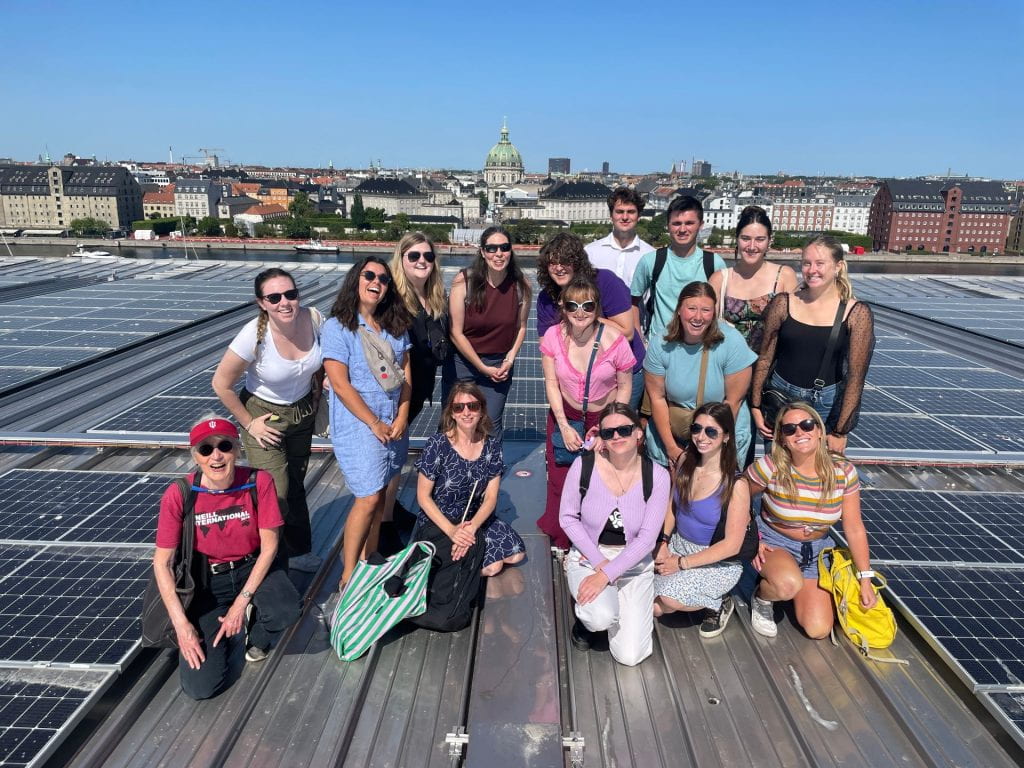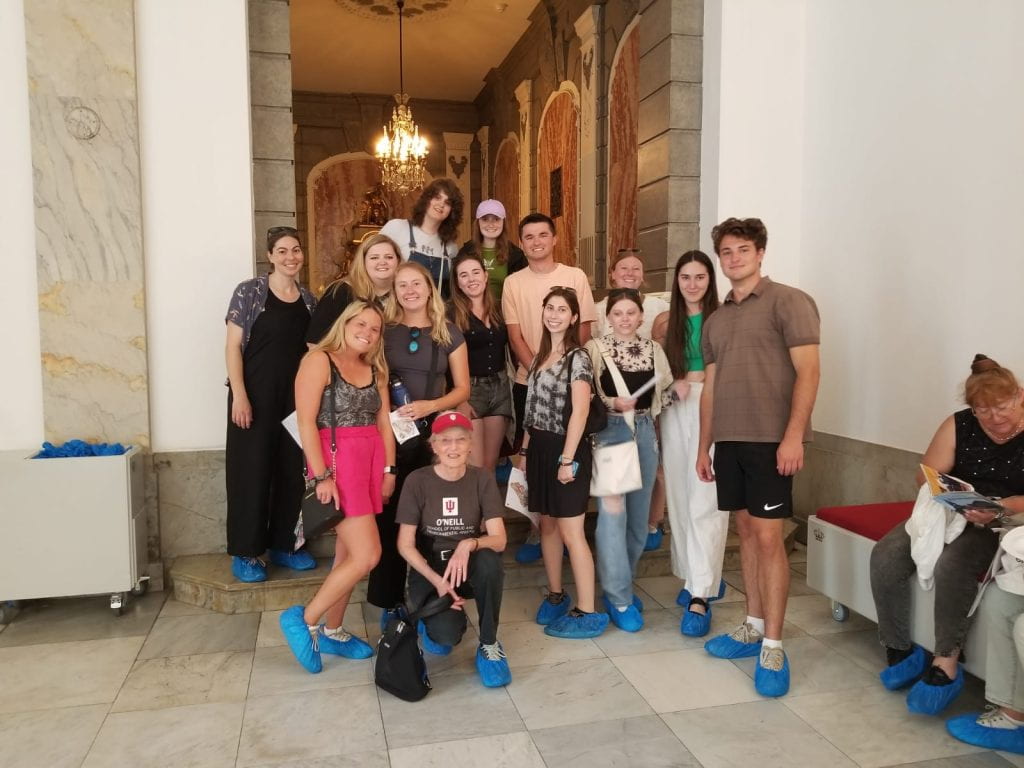My name is Gie Wilson, and I work in the Office of the Vice President for International affairs as IU Global’s Sustainable Development Goals Ambassador. I promote the local and global impacts of sustainable development within Indiana University and across our partners on campus and around the work through a variety of tasks, including this blog. Despite my limited personal international experience, through my coursework in Environmental and Sustainability Studies as well as my work with IU Global, I am no stranger to the concept of global partnerships. However, rather than exchanges or multinational corporations, the first thing that now comes to my mind when I think of global partnerships is a Danish handball team.
To understand this, we have to go back to Amager Sports Club in Copenhagen, in June of 2023. A group of students from Indiana University, myself included, none of whom are professional athletes, stood in a nervous clump around a local Danish volunteer handball coach. After running a brutal mile, doing sprints, and plyometrics we filtered onto the handball court, red-faced and sweaty. We were each paired with one of the female athletes who played on the local team. Despite lots of wild throws- I even drilled the goalie in the face with a ball at one point- they were all so patient and kind. They taught us the rules and showed us tricks, and we compared and contrasted them with sports associations in the United States. In the final scrimmage, there were multiple plays set up by Danish players and finished by IU students, exemplifying the spirit of successful partnership.

I didn’t expect to see the power of international engagement on a handball court when I applied for the O’Neill School of Public and Environmental Affairs program, V482 O’Neill in Denmark: Nonprofit Sector in Comparative Perspective. I spent three weeks in Copenhagen with twelve other students, two instructors, and one O’Neill Staff member, fundamentally changing my concept of global citizenship and participation.
“Classes will focus on a comparative perspective, introducing students to alternative shapes of nonprofit organizations and civil society. Class sessions will include lectures from both O’Neill faculty, Professor Kirsten Grønberg and Professor Allison Schnable, and Danish nonprofit and political leaders, as well as visits to political, historical, and nonprofit sites around the city.”


That blurb from the program overview is about as much as I knew when I arrived at Copenhagen Airport (Københavns Lufthavn) flying over rows of wind turbines as the plane touched down. I had only been out of the country once before, on a brief school trip in high school, and had never flown by myself. I was nervous, confused, and about as vulnerable as I could’ve been. But upon arriving in Indre By, my new neighborhood for the next few weeks, I was astonished by the warm reception.
As I quickly learned, community is an integral aspect of Danish life. Our apartment complex had a large communal courtyard in the middle, where local children came to play together, and a cat named Mickey roamed. In addition to the warm welcome from my new feline friend, there was something else that caught my sustainably-minded eye; in the courtyard there were accessible and robust waste management mechanisms. Separate bins were labeled by type, such as soft and hard plastic, and used by everyone within that block. There was an additional incentive to take your time sorting your waste since the entire block would be fined for incorrect waste disposal, a real-world example of integration of community and consequences into sustainable practices, and the subsequent impact. I did not expect to be so quickly immersed in Danish culture, nor did I think I would be confronted with my passion for sustainability on the very first night.
Part of the reason why it is possible for this communal aspect to be so prevalent in Danish life is its size. Being a small nation affects every sector, from health care to civil society. Even public transportation is easier to develop and maintain with a smaller size, something for which I was very grateful as a rookie traveler.

This size also made it possible for my classmates and I to meet ordinary Danish citizens on a regular basis rather than just hearing from politicians and experts. Going into the program, I had expected that our exploration of Danish nonprofits would be limited to simply researching and reading about them, but I was ecstatic to find that we were having hands-on interactions with a variety of organizations providing multiple perspectives.
It was in these more informal spaces that I was able to find the most freedom to explore my own interests within the context of the course. I badgered people I met in restaurants, at site visits, and even my own classmates with questions about their relationships with sustainability. I found that even with all this community and the benefits of being smaller, many Danes disagreed with the politicians and some experts on how “green” Denmark really is.
Despite the fact that I work at IU Global as an SDG Ambassador, I came into this program with a few generalizations about how the public views sustainability. I thought that the average person didn’t know more about sustainability because they didn’t care to. However, throughout my experience I learned that many people, Danish and American alike, didn’t seek answers on sustainability because they felt a sense of gridlock on where to start. Even though it was not explicitly geared towards it, this program provided space for people who don’t always think about sustainability to have meaningful conversations. For those who spend most of our time thinking about it within like-minded circles it allowed us to branch out and expand our perspectives. I even got the chance to collaborate with peers on how to incorporate sustainable practices in future endeavors and found that nearly all agreed that this was a necessary conversation. Reaching a consensus is progress, and something I will bring back to my academic and professional work in Indiana.


In addition to this newfound understanding, I will bring back additional lessons I’ve learned around organizing and advocacy. I’ve learned about tools I have at my disposal- how nonprofits at home and abroad are beginning to blossom as a vessel for sustainability when government initiatives cannot or will not. How we as a society are able to adapt and evolve better now than ever before due to the ability to communicate nearly instantaneously, as well as the normalization of sustainable practices into the development of the next generation.
One of the lectures that was pivotal to this understanding concept was by a Danish green activist, community organizer, and author Andreas Lloyd . He shared a diagram he developed that dissects the methods and factors involved in any advocacy, but especially sustainable advocacy.


It captures the many different categories and dichotomies contained within “activism.” It can be organizational, as in run by staff, or movement focused, which is based on volunteers. It could have confrontative or angry overtones, or diplomatic or happy overtones. Each strategy has its own focus, campaigns, communication, protest, or community, and isn’t limited to just one or the other: it can be a combination of these to a different degree. Using this map as a tool for approaching advocacy, especially sustainability activism, is something I intend to use for the rest of my career and have already used to dissect movements I am a part of and have seen.
The Danish handball team fits within all of this. It all connects and revolves around partnership and collaboration. During the course, we discussed at length the importance of partnership, not only within civil society but between government and private sectors as well. They are able to fulfill the role the other sectors can’t for various reasons. By having a strong nonprofit sector partnered with a just democratic government, advocacy has many places to exist. These two themes are not just a priority in Denmark and America, but globally. The United Nations Sustainable Development Goals (SDGs) lay them out as a specific priority of all nations through SDG 16, Peace Justice and Strong Institutions, and SDG 17, Partnerships for the Goals. These are goals that Indiana University actively pursues and strives to provide opportunities for students to pursue as well. I am a part of the team that fosters and promotes this work, but there is a difference in hearing about it and being able to experience it myself on the ground in another country.
So back to the handball team, which was so impactful in teaching me about partnership. I never thought I would be sweating on a handball court with strangers. The team, and the experience, exemplifies how through global connections and personal growth you can achieve something that seems impossibly lofty alone. One of the course instructors for this program, Professor Allison Schnable, perhaps said it best, “We are living in a moment of great uncertainty and change. What international study gives us that is so important is an opportunity to understand ourselves better, and to glimpse the breadth of what is possible in the world.”
After my own experience, I implore you to explore how connected you are globally- because whether you realize it or not, we are all intrinsically connected on a global level. Even without international travel, you still have the tools at your disposal to engage in personal and societal growth and sustainable action. This could look like hundreds of different things: getting involved in local civil society, or talking to someone from a different background, or reading more about the SDGs and how they connect in your life. What you do and how you do it is less important than the fact that you are doing it. All that matters is that you help us all play the game.
Leave a Reply